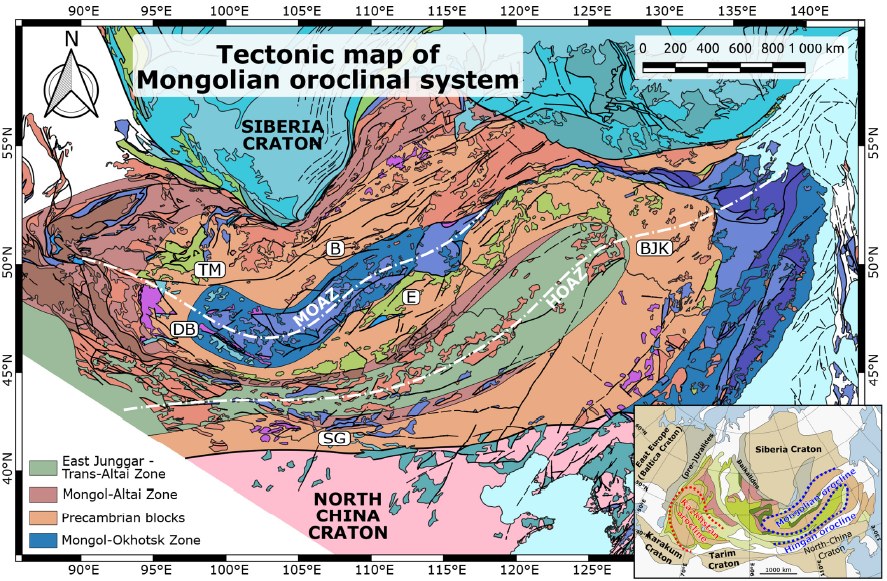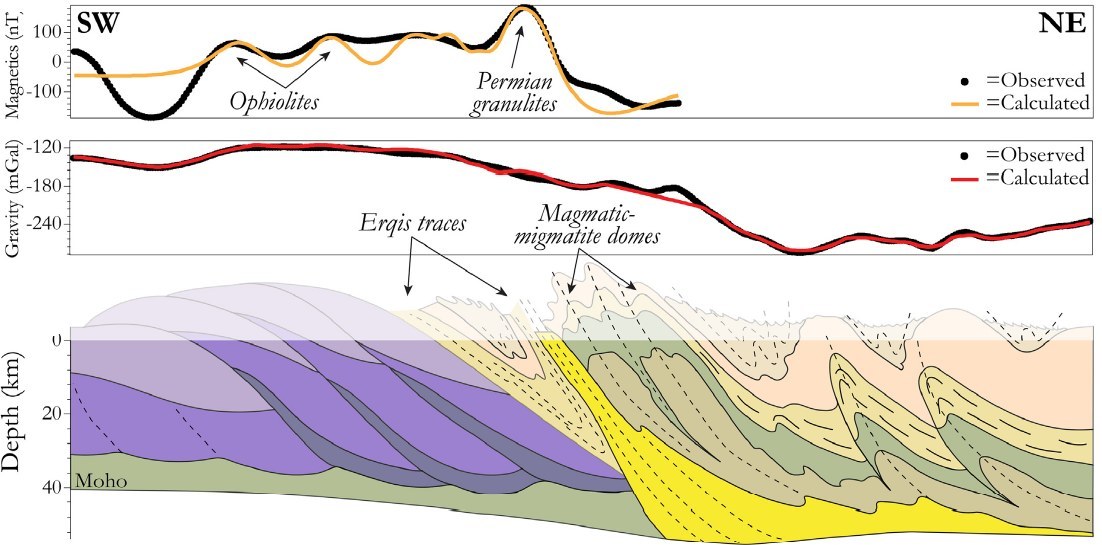Geodynamics of accretionary orogenic systems namely the Central Asian Orogenic Belt and its comparison to west Pacific systems
Accretionary orogens are long lived (several hundred million years) orogenic systems currently developed along the Pacific convergent margins. Here, the process of accretion of oceanic sediments, continental blocks, arcs and back arcs along subduction zones is well characterized, but it remains obscured in fossil orogenic belts due to subsequent reworking. The tectonic evolution of a fossil accretionary system exemplified by a giant Central Asian Orogenic Belt (CAOB) or Altaides is one of the main topics of our group. Our research is focused on characterization of newly identified processes responsible for the formation of mature lower crust associated to cratonization of accretionary wedges [link], horizontal redistribution of hot lower crust and its exhumation in the form of giant lower crustal domes [link] [link]. The last topic related to the CAOB is a study of oroclinal bending mechanisms which have been recognized in this region. An attempt is made to understand how this process is related to lower crustal reequilibration and deep asthenospheric flow [link]. The comparison of CAOB with modern western Pacific and Tethysian systems can shed light on cyclic „introvert“ evolution of Pangea supercontinent in Asia and Europe, and on formation of the Trans-Euroasian Orogenic Belt which results from suturing of this supercontinent.
Tectonic map of the Central Asian Orogenic Belt. [link]
Geodynamics of the Central Asian Orogenic Belt
The CAOB is the largest Earth accretionary system and is currently the most studied area in the whole world thanks to occurrence of giant mineral resources deposits. The tectonic evolution of this belt occurred during two main events related first to large scale Pacific type subduction and followed by convergence of Gondwana derived cratons with Siberia in the north. The global material budget, time scales and mechanisms of these two geodynamic events is not understood as yet. Ten year history of annual expeditions to Mongolia, China and Russia in collaboration with Mongolian, Chinese, Russian, French and US partners lead to progressive unravelling of most exciting and complex geodynamic history of this critical region where accretionary systems passes to collisional orogen and where Asian continent grown at exceptional rate in Paleozoic.
Observed and calculated magnetic and gravity anomalies along a profile in northwestern China; simplified geological cross-section along the profile. [link]
Formation of mature lower crust, its flow and exhumation in the CAOB
The origin of lower crust in Central Asian orogenic Belt is generic question not answered in any accretionary systems in the world. The juvenile accretionary wedges are molten during roll back of oceanic subduction zones thereby forming large zones of partially molten material. The latter becomes redistributed underneath back arc oceanic crust during subsequent contraction events forming inverted density crustal profiles. The allochthonous lower crust is exhumed along giant migmatitic domes cored by juvenile plutons in Chinese and Mongolian Altai. The fascinating processes of cratonization of lower crust, its flow and final exhumation are studied using geophysics, petrology and structural geology.
Left: Analogue model of crustal-scale detachment folding and exhumation of partially molten crust. Right: Scenario of extrusion of the Chandman dome in the Mongolian CAOB based on structural and geochronological data. [link]
Mechanisms of oroclinal bending along the vertical axis
Oroclinal bending along vertical axis is a mechanism, which attracts a lot of attention to explain geology of Iberia, Kazakhstan, Mongolia and range of regions along Pacific convergent margins. We perform large scale structural and geochronological studies combined with paleomagnetic investigations to characterize this process in Mongolia. While the understanding of oroclinal bending kinematics is straightforward, the mechanisms of bending together with response of asthenospheric mantle and orogenic lower crust remain obscured. 3D analogue modelling combined with tracking of linear zones of alkaline magmatism in Mongolia and China are used to understand the coupling between upper mantle and crust during this process.
Trans-Eurasian Orogenic Belt and suturing of the Pangean supercontinent
The result of comparative study of European and Asian Paleozoic orogenic evolutions leads to definition of Trans-Euroasian Orogenic Belt which results from suturing of Pangean supercontinent in Permian times. Amalgamation of continental crust blocks in west and accretion of continental ribbons with oceanic crust and accretionary wedges in the east result in two types of Devono-Carboniferous orogens with clear E-W zonation. Subsequent shortening related to the closure of Paleotethys and suturing of Pangea led to different thermomechanical response along E-W trending orogen. Understanding of this process and its relation to mantle convection cells dynamics is one of the major highlights of our research in future.
Related projects
Principal mechanisms of peripheral continental growth during supercontinent cycle (2019–2023)
Crustal growth and construction of continental crust exemplified by Central Asian Orogenic Belt (2012–2015)
The role of Paleozoic accretionary and collisional orogens on the formation and growth of continental crust (2012–2016)



